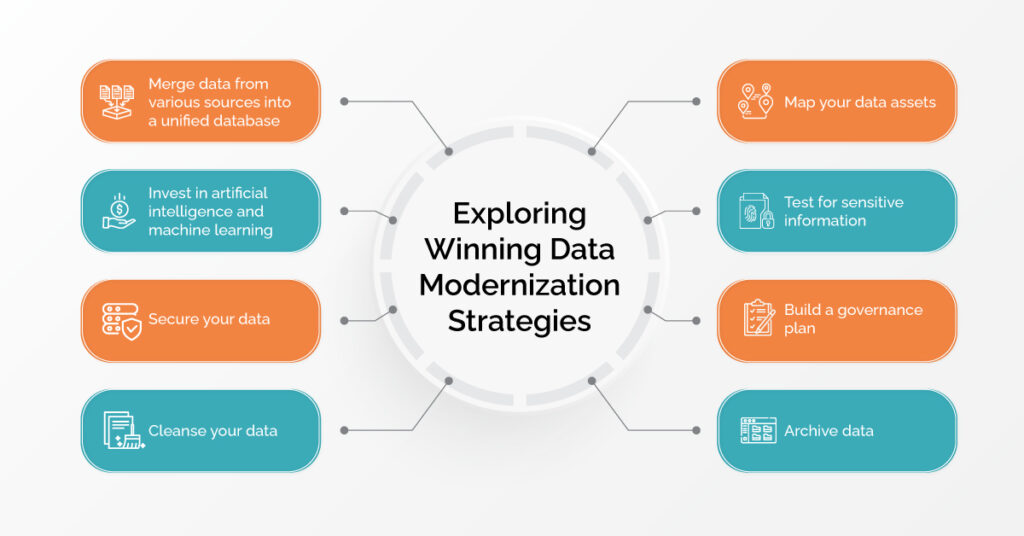
How to Make Data Modernization Your Winning Strategy?
In today’s digital era, data is the most valuable asset for companies as it empowers decision-making abilities. However, companies must equip themselves with data management processes and tools to effectively manage the vast amount, speed, and diversity of data they generate.
Data management strategies such as data analytics and integration help companies optimize their use of data as a strategic asset. Data modernization is critical in addressing the challenges of outdated legacy data management systems.
In this guide about data modernization, you can learn about its benefits, how it functions, and some of the best data modernization strategies for organizations to modernize their data. Let’s dive in and unlock business value with data modernization.
What is Data Modernization?
Data modernization refers to transferring existing siloed data from outdated platforms to modern cloud-based systems where it can be cataloged and protected such that it can be used and applied by every employee in the company as early as it is collected. Modernized data helps users to explore features such as advanced analytic functions, interactive visualization tools, mobile access, and machine learning capabilities.
Cloud-based data and analytics modernization offer virtually limitless storage and unparalleled processing speed and power for advanced analytics at an appropriate price point. New high-velocity data can be easily correlated with outdated siloed data, such as web clickstreams or IoT sensor data, and unstructured data, like videos, blog posts, or PDF documents.
Exploring Winning Data Modernization Strategies
Your company can choose from several data modernization strategies, such as data governance or open data management. The need of your organization or company defines the strategy they select. Moreover, the following steps are considered while creating a winning data modernization roadmap.

- Merge data from various sources into a unified database: Data is often dispersed across multiple business systems and applications. Consolidating this data into a single database can be a viable solution to ensure it is easily discovered, accessible, and up-to-date. By establishing a consolidated database that accesses data from diverse sources, companies can derive fresh insights, allowing them to scrutinize all the various data sets they have gathered over time.
- Map your data assets: Knowing what types of assets are present in your organization is a crucial stage for any data modernization effort. Detailed information about data assets, the type of data being collected by different units, where data is stored across the network, data format, and age help you to know the best actions required for data modernization.
- Invest in artificial intelligence and machine learning: Artificial intelligence and machine learning techniques provide several advantages for modernizing company data. Some of the main functions of these techniques about data are predictive analytics, workflow automation, and automated extraction of unstructured data.
- Secure your data: Data modernization often includes moving and exposing data in and around new users and applications. You can use encrypted links to shift data across open networks such as cellular networks or Wi-Fi to secure your data. Encryption involves jumbling up the information of a file or message. This makes accessing data without proper authorization challenging, rendering unauthorized individuals away from sensitive organizational data or information.
- Test for sensitive information: Sensitive information involves any data that could potentially breach regulations about privacy, intellectual property rights, or business ethics. Such data include intellectual property, financial records, health records, and personally identifiable information (PII). Testing and identifying sensitive information is crucial to ensure compliance with industry standards and regulatory mandates like GDPR and HIPAA, irrespective of how an organization modernizes and transfers its data.
- Build a governance plan: A governance plan is significant in data modernization. It explains who owns, accesses, and maintains data and involves detailed rules regarding how data must be used. Through an effective governance plan and the right processes and individuals to enforce it, your data will be secured and compliant while focusing on transforming and modernizing it.
- Cleanse your data: Another effective approach for data modernization is data cleansing. It eliminates invalid, redundant, inaccurate, or erroneous values from current fields, thereby retaining only relevant and accurate information. Data cleansing is also an essential step to conduct before big data migrations.
- Archive data: Archiving data allows long-term digital information storage and often preserves older file versions. Once an archive is established, copies of data can be distributed to other locations for backup purposes. Often the data modernization process leads to data loss for companies that are not cautious. It is crucial to have data archives and backup solutions in place.
Benefits of Modern Data Architecture
A well-architected data model supported by a cloud-based database help employees to get a single point access and cohesive view to distributed data assets and enables companies to:
- Enhance the data storage and management system security: Modern database systems offer improved monitoring and threat detection abilities to prevent unauthorized access and protect sensitive data.
- Streamline data governance: Use consistent data expiration, collection, and access rules to comply with data privacy and protection guidelines.
- Bring data from several sources together: Bridging companies silos for effective decision-making and collaboration.
- Allow data discovery: Perform and maintain a data catalog, making accessibility easier. The latest data catalog is a crucial element that protects private data.
- Extract insights from unstructured data: Use cutting-edge, easy-to-use machine learning cloud services to surface knowledge hidden in the company’s user data.
- Be a data-driven company: To ensure access to the correct information at the right time and seek actionable, valuable insights to make real-time decisions for the company.
- Become big data-friendly: Big data is defined by three Vs.: variety, velocity, and volume. Modern databases are developed to store and ingest heterogeneous information at high speed, easily scaling with the increasing requirements while remaining cost-effective.
Bottom Line
With the right data modernization strategies and services and an effective governance plan, companies can decide what is essential for their users rather than wasting resources and time consolidating via several data stores for relevant data. This causes improved customer retention and satisfaction rates and substantial savings in money, resources, and time spent across the company.




